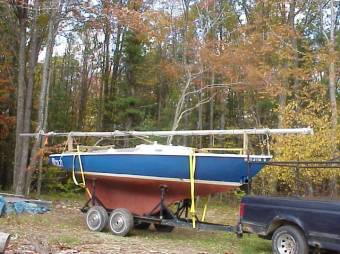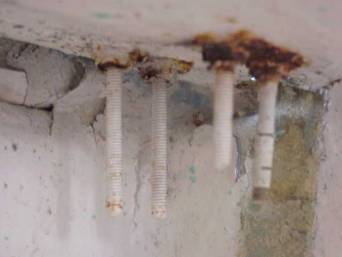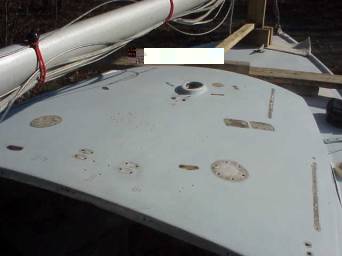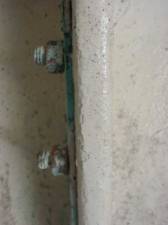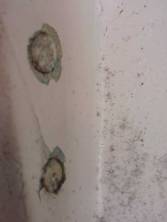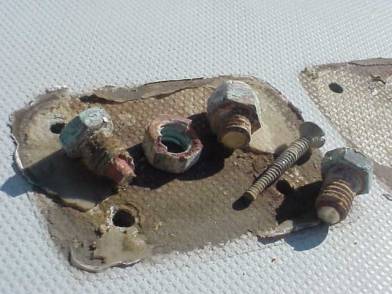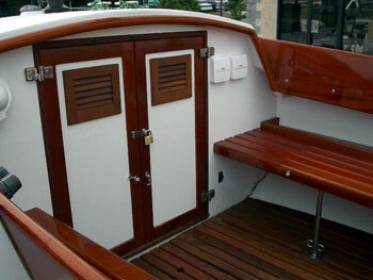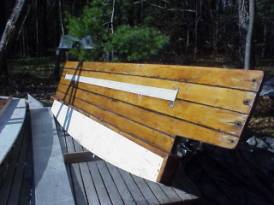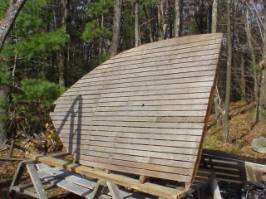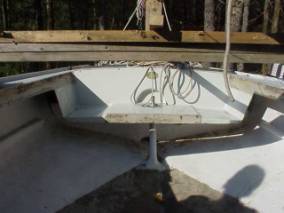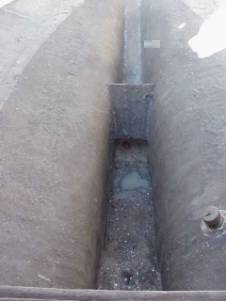Notes on Restoration of Ensign 841
Ensign 841 had spent most of its life in Newport, Rhode Island before being purchased in October 2002. The boat was structurally sound, but suffered from long-term exposure to the elements of salt water, haphazard repairs, and benign neglect. It was obvious from an initial inspection that the reclamation of the physical charm and sailing efficiency inherent in the Ensign design would cost more time than money, but where to start?
Without much deliberation, we decided that the long neglected brightwork, deck, cockpit and cabin surfaces had to be addressed. To proceed with this initial work, the first phase was to strip the boat of hardware and brightwork. This will facilitate surface prep and finishing, and allow for inspection and consideration of replacement/relocation of fasteners and hardware. The removal phase was difficult due to the effects of exposure to salt water, neglect of routine maintenance, and apparent indifference to how boat maintenance was performed. Thus, the choice of whether to "pay now or pay later" is well illustrated in this case. Those who choose the "pay later" option, usually do so at the expense of future owners. In this case, years of applying paint and varnish, without removing hardware or controls, resulted in an accumulation of layers of paint and varnish on screw and bolt heads, washers, threads, blocks, cleats, etc. which effectively froze hardware fasteners. Instead of simply backing-out screws and bolts, in many instances we had to resort to an impact driver, wire brush, cold chisel, reciprocal saw, and hacksaw to remove hardware. If we were lucky, a through bolt would break-off and the remaining piece(s) could be pushed out the other side. If we were unlucky, a broken piece had to be drilled out.
In addition to the frozen or coated fasteners, there was metal fatigue caused by natural exposure to salt and the placement of incompatible metals in physical contact with one another. We found that the extent of metal deterioration from fatigue was not evident until after a fastener was removed. Another complicating condition was the fact that hardware was secured without appropriate washers and/or backing plate. In many instances, bolt heads and nuts were embedded into the fiberglass, making removal very difficult.
On the positive side, without the above-mentioned complications, stripping the boat of all hardware and brightwork in anticipation of painting or periodic inspection can be very easy.
Hardware removal can reveal some startling findings. For example, the structural integrity of the winch mounts were severely compromised by successive winch replacement/repositioning, without filling previous mounting holes.
This is a not too uncommon condition which evidenced incompatible metal corroding and inappropriate bolt lengths-in this instance protruding overhead in the cabin. Also note, how nuts and threads were painted over.
With all of the hardware removed, relocation and/or replacement of deck hardware, resurfacing non-skid areas, and painting will be much easier.
These are photographs of chain plate bolts. Not only were these bolt heads installed without any means of preventing them from being drawn into and embedded into the fiberglass, but approximately 30% of these bolts were severely deteriorated and fatigued to a frail breaking point.
Once the deck hardware and brightwork were removed, the only remaining items were the cockpit benches and sole. Taking out the benches required the removal of a dozen bolts. The one-piece cockpit sole was held in place through the pressure of the bench legs. We decided to upgrade the wooden bench legs with a set of adjustable stainless steel bench legs purchased from Ensign Spar, Inc.
And this is a picture of our newly restored, 1965 Ensign. NOT! This is a photograph of a newly minted Ensign illustrating the new stainless steel legs mentioned above.
Photographs of the cockpit bench, top and under side of the cockpit sole.
The following pictures are of the cockpit stripped and ready for prep and finishing.
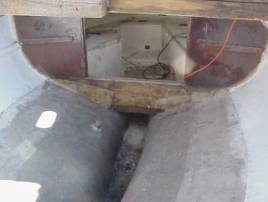
Contact us if you'd like to learn more about Ensign sailing.
